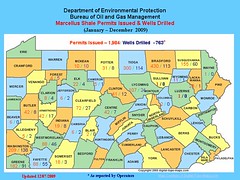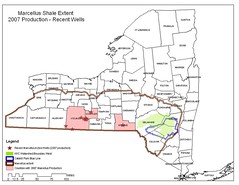By AP_Exchange
December 1, 2009
PITTSBURGH (AP) A Pennsylvania environmental group is suggesting five recommendations it says will help ensure gas drilled in the Marcellus Shale is done safely.
PennEnvironment recommends improving the public's right to access information about drilling, keeping some areas off limits to drilling and creating mandatory penalties for polluters. The group also recommends increasing state Department of Environmental Protection funding for expanded enforcement and strengthening existing clean water laws.
PennEnvironment released its recommendations Tuesday.
The potentially lucrative Marcellus Shale gas formation lies under about 60 percent of Pennsylvania. Environmentalists say drilling has polluted water and threatens public health.
on draft SGEIS in Corning, November 18, 2009
Knowing a man whose water well was contaminated after seismic testing was done on his neighbor’s property, hearing a speaker from Pennsylvania who had a fish kill in his pond when the plastic liner of the evaporation pit leaked, and having read about benzene in water wells in Wyoming and ground-level ozone in rural Colorado, I think it is crucial that this draft be greatly strengthened after the EPA does its study of hydraulic fracturing. Here are some suggestions.
There will be thousands of truck trips per well pad. Diesel exhaust downwind can cause health problems from asthma to cancer (see studies attached). Therefore all trucks should be required to have diesel filters. The technology exists, right here in Corning, and New York could become a leader for other states to follow.
The report says private water wells within 1,000 feet of a gas well will be tested before drilling. That’s good but not good enough. Drilling may go 5,000 feet horizontally; so wells within a mile should be tested before drilling, a month after fracking, 6 months later and every year thereafter.
Setbacks of 2,000 feet are required for municipal water resources but only 150 feet for private wells. That’s discrimination. There should be a one-mile set back for drilling near any drinking water supply.
Since concrete can crack, the surface casing must cure long enough to withstand drilling. Therefore an inspector must be on site not only when the concrete is poured but also when the decision to drill is made, lest drillers start too soon to save time and money.
For drilling, “green” non-toxic chemicals should be used, as is done offshore. Very dangerous chemicals like 2-butoxy ethanol (an endocrine disruptor) and hexavalent chromium (a potent carcinogen) must be banned. The latter is notorious from the film “Erin Brockovich.” It now contaminates some 30 water wells near drilling in Midland, Texas, and cancer rates are high. In section 5.11.3 (p. 5-102) of this document chrome 6 is listed as typically found in the flowback from fracking in Pennsylvania and West Virginia. The DEC must prevent this.
CLICK HERE to read about Schlumberger's "Green Slurry", an environmentally safe fracking fluid developed for use in "environmentally sensitive regions". What kind of industrial and/or regulatory arrogance has determined that there is anywhere that is not an environmentally sensitive region??? WRITE LETTERS! DEMAND THE USE OF ENVIRONMENTALLY SAFE SOLUTIONS!!!Another option is “green completions” instead of venting and flaring which emit volatile organic compounds (VOCs) and nitrous oxides. When combined in the presence of sunlight, these cause ground-level ozone, a mere speck of which burns holes in lung tissue. The Dallas/Fort Worth Airport required green completions in its deal with Chesapeake Energy in 2006. The DEC must require it in 2010.
In the draft document steel tanks are suggested for waste water. They should be required. Drilling permits should not be granted until viable treatment of the wastefluid is in place. With recent news that samples of brine analyzed by the DEC had excessively high levels of radium 226, the DEC must find a way to safely deal with radioactivity.
In conclusion, given shortcomings like the ones mentioned above and given the fact that the cumulative effect of all wells has not been addressed in the report, the DEC must redo the study and make very strong requirements if unconventional drilling is to be allowed. With DEC’s lack of money and manpower, however, the State of New York must levy a severance tax on the gas industry to fund the enforcement. Without both of these in place, an environmental and health disaster is inevitable.
Editorial comments by Splashdown in red.



















No comments:
Post a Comment